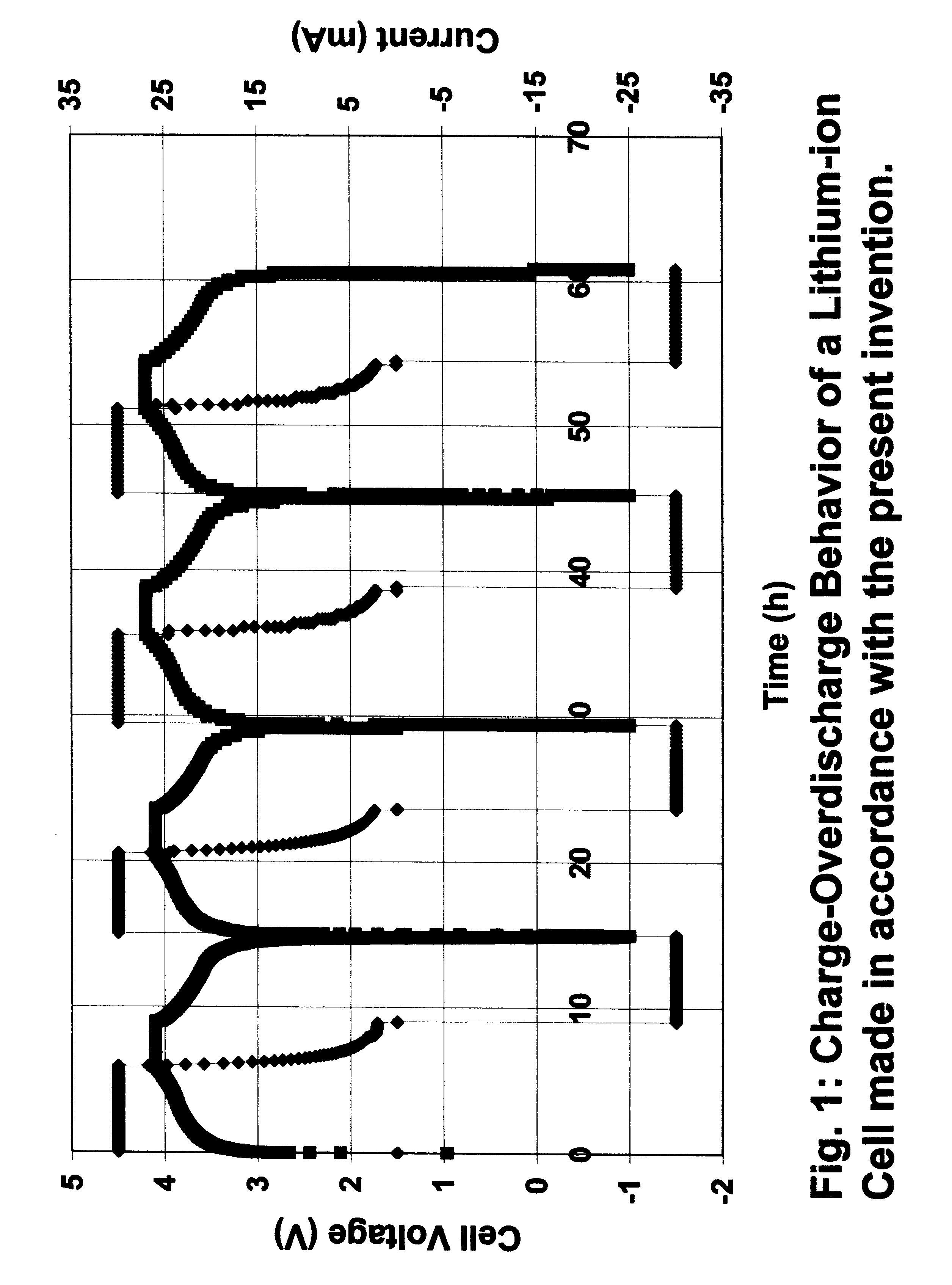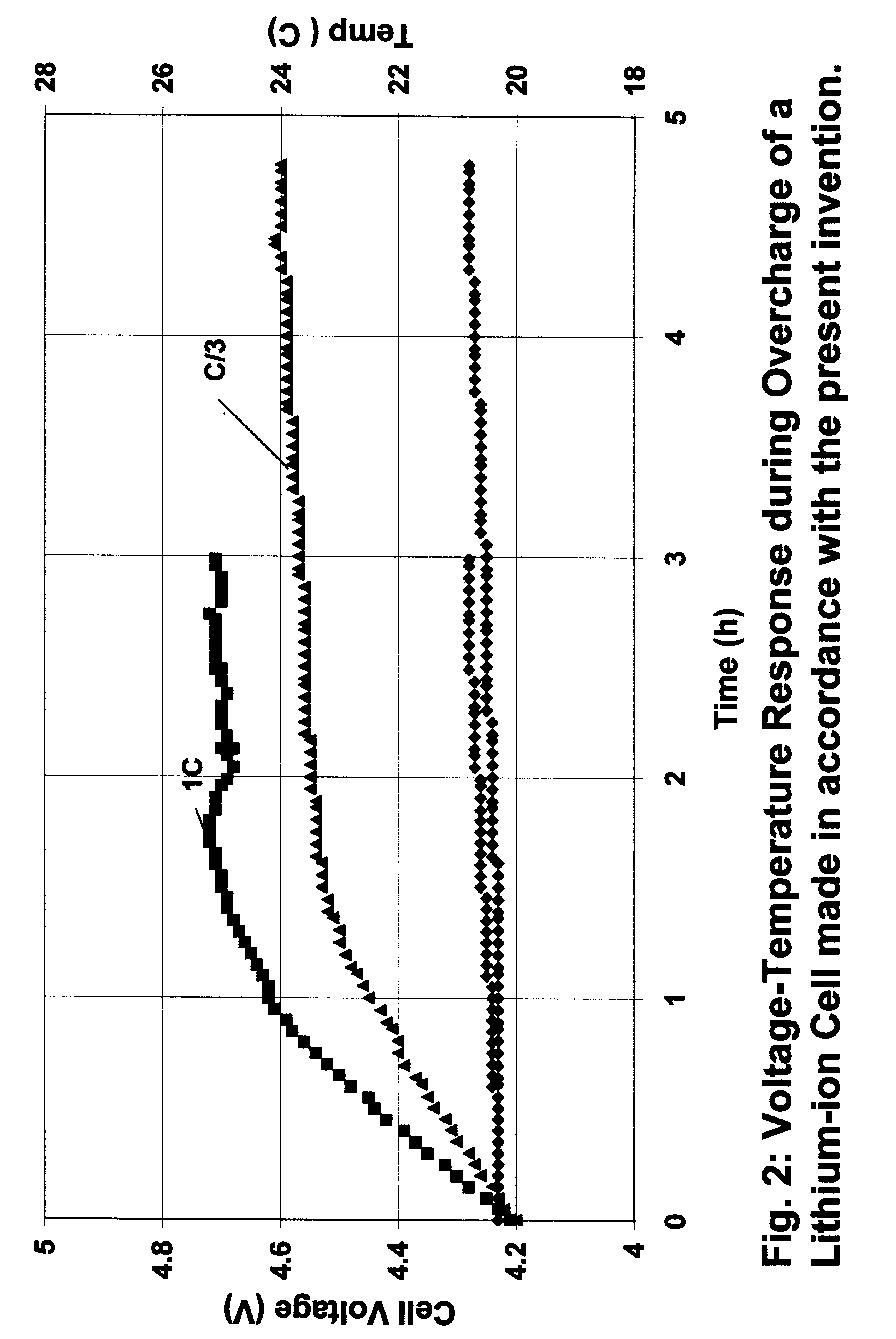Secondary non-aquenous electrochemical cell configured to improve overcharge and overdischarge acceptance ability
a non-aqueous electrochemical and cell technology, applied in the field of lithium-ion batteries, can solve the problems of degrading cell performance, heat build-up, and ultimately thermal runaway of the cell, and achieve the effects of improving the acceptance ability of overcharge/overdischarge, reducing the cost and weight of lithium-ion cells, and high electronic conductivity
- Summary
- Abstract
- Description
- Claims
- Application Information
AI Technical Summary
Benefits of technology
Problems solved by technology
Method used
Image
Examples
examples 2
A lithium-ion cell was made as in Example 1 with the carbon-carbon composite heat treated to 2800.degree. C. as anode, lithiated cobalt oxide as active cathode material and an electrolyte comprising 1 M LiPF.sub.6 in a mixture of ethylene carbonate and diethyl carbonate (1:1 v / v). The cell was first charged at a constant current of 0.5 mA / cm.sup.2 to 4.1 V and then at a constant voltage (4.1 V) for a period of three hours or until the current dropped to 0.02 mA / cm.sup.2. The cell was then discharged at a constant current of 0.5 mA / cm.sup.2 to a cut-off voltage of 3.0 V. The charge-discharge process was repeated at least two times in order to obtain a cycling efficiency greater than 99%. The cell was then used to carry out the overcharge experiment.
The voltage and temperature response of a fully charged cell during overcharge at two different rates is shown in FIG. 2. The temperature recorded was the outside body temperature of the cell. At 1C charge rate, the cell voltage raised to ...
examples 3
A lithium-ion cell was made as in Example 1 with the carbon-carbon composite heat treated to 2600.degree. C. as anode, lithiated cobalt oxide as active cathode material and an electrolyte comprising 1 M LiPF.sub.6 in a mixture of ethylene carbonate and diethyl carbonate (1:1 v / v). The cell was first charged at a constant current of 0.5 mA / cm.sup.2 to 4.1 V and then at a constant voltage (4.1 V) for a period of three hours or until the current dropped to 0.02 mA / cm.sup.2. The cell was then discharged at a constant current of 0.5 mA / cm.sup.2 to a cut-off voltage of 3.0 V. The charge-discharge process was repeated at least two times in order to obtain a cycling efficiency greater than 99%. The cell was then used to carry out repeated overcharge / overdischarge experiment.
FIG. 3 shows the repeated overcharge-overdischarge characteristics at 50 mA of the lithium-ion cell made in accordance with the present invention. There was no safety hazard or thermal run away of the cell. The cell can ...
PUM
 Login to View More
Login to View More Abstract
Description
Claims
Application Information
 Login to View More
Login to View More - R&D
- Intellectual Property
- Life Sciences
- Materials
- Tech Scout
- Unparalleled Data Quality
- Higher Quality Content
- 60% Fewer Hallucinations
Browse by: Latest US Patents, China's latest patents, Technical Efficacy Thesaurus, Application Domain, Technology Topic, Popular Technical Reports.
© 2025 PatSnap. All rights reserved.Legal|Privacy policy|Modern Slavery Act Transparency Statement|Sitemap|About US| Contact US: help@patsnap.com



